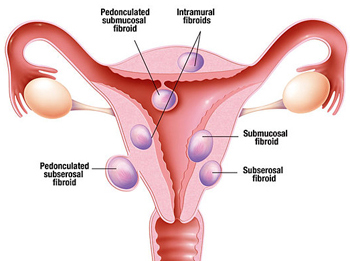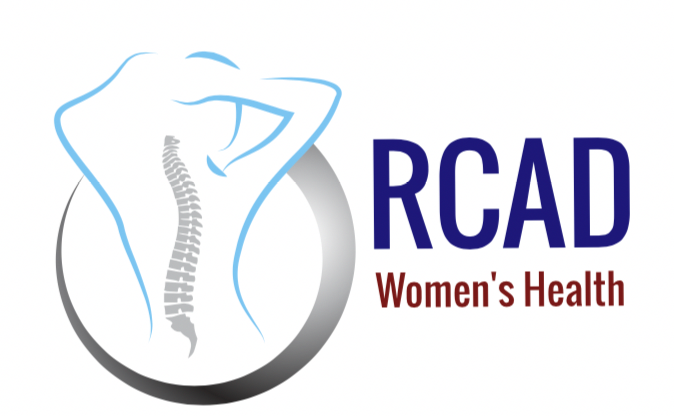Fibroids are non-cancerous (benign) tumors that grow from the muscle layers of the uterus (womb). They are also known as uterine fibroids, leiomyomas or myomas.
- An estimated 1 in 5 women will be affected by fibroids during their life
- Researchers do not know exactly why fibroids form
- Most people experience no symptoms at all, but they can include backache, constipation and anemia.
We will start our focus on some key points about FIBROIDS:
What are fibroids?
Fibroids affect at least 20 percent of all women at some point in their life.
Women of reproductive age are the most likely to develop them. Also, overweight and obese women have a significantly higher risk of developing fibroids, compared with women of normal weight.
Four types of fibroids:
There are four types of fibroids, characterized by their location in the uterus:
- Intramural-located in the wall of the uterus, this is the most common type.

Uterine fibroma - Subserosal fibroids-located outside the wall of the uterus but underneath the tissue layer that surrounds the uterus. They can develop into pedunculated fibroids (stalks) and become quite large.
- Submucosal fibroids-located in the muscle beneath the lining of the uterus wall. This type can protrude into the cavity of the uterus.
- Cervical fibroids-located in the neck of the womb (the cervix).
Causes of fibroids:
Experts cannot come to a common consensus about why fibroids occur. During a woman’s reproductive years, estrogen and progesterone are high. When estrogen levels are high, especially during pregnancy, fibroids tend to swell. When estrogen levels are low, fibroids may shrink, for example, during a woman’s menopause.
Heredity may also be a factor: women whose close relatives have had fibroids have a higher risk of developing them. There is also some evidence that red meats, alcohol, and caffeine could increase the risk of fibroids. Also, an increased intake of fruit and vegetables might reduce the risk.
Diagnosis of fibroids:
In most cases, the symptoms of fibroids are rarely felt, and the woman does not know she has them. They are usually discovered during a vaginal examination.
- Ultrasound-can detect fibroids and eliminate other possible conditions which may have similar symptoms. An ultrasound can be used over the abdomen or transvaginal (a small probe is inserted into the vagina). This may help visualize cervical and submucosal types better.
- MRI – this is the best type of imaging to determine the size of fibroids and if there are multiple fibroid in the uterus. However, MRI can be quite expensive and may not be available in many areas in the world.
- Hysteroscopy- a small telescope to examine the inside of the uterus. During this procedure, if necessary, a biopsy (small tissue sample) can be taken of the lining of the uterus.
- Laparoscopy- a laparoscope is a small flexible tube used to examine the outside of the uterus. During this procedure, if necessary, a biopsy can be taken from the outer layer of the uterus. This is a surgical procedure that would require cutting through the skin.
Treatments for fibroids:
If the woman has no symptoms and the fibroids are not affecting her day-to-day life, she may receive no treatment at all. Even women who have heavy periods but whose lives are not badly affected by this symptom may also opt for no treatment. Annual women health examination must be maintained.
During menopause, fibroids usually shrink, and symptoms will often become less apparent, or disappear altogether.
When treatment is necessary, it may be in the form of medication or surgery.
Surgery to treat fibroids:
Depending on symptoms and whether medical therapy has failed. The following surgical procedures may be considered.
- Hysterectomy: May include removal of the ovaries and fallopian tubes
- Myomectomy: This option is more popular for women who want to get pregnant. Women with large fibroids may not be able to benefit from this surgery.
- Endometrial ablation- removing the lining of the uterus. This procedure may be used if the patient’s fibroids are near the inner surface of the uterus.
- Uterine artery embolization (UAE): this treatment cuts off the fibroid’s blood supply, effectively shrinking the fibroid. A chemical is injected through a catheter into a blood vessel in the leg, guided by X-ray scans.
- Magnetic-resonance-guided percutaneous laser ablation – an MRI scan is used to locate the fibroids. Then, very fine needle are inserted through the skin and pushed until the targeted fibroids are reached. A fiber-optic cable is inserted through the needles. A laser light goes through the fiber-optic cable and shrinks the fibroids.
- Magnetic-resonance-guided focused ultrasound surgery– an MRI scan locates the fibroids, and sound waves are used to shrink the fibroids.
There is some uncertainty regarding benefits / risks. It is important to stress that successful outlook is driving by knowledge of the situation or condition.
Complications Associated with Fibroids:
- Menorrhagia (heavy periods) – the most common complication, disruption of the women’s ability to function normally when her periods are present. Also the possibility of depression because of inconvenience and discomforts. Menorrhagia can lead to anemia and fatigue.
- Abdominal pains – if the fibroids are larger, the woman may experience swelling and discomfort in the lower abdomen. She may also have sensation of being constipated. Some women with large fibroids say their bowel movements are painful.
- Premature birth, labor problems, miscarriages – as estrogen levels rise significantly during pregnancy, and as estrogen can speed up fibroid growth, some women may experience early labor, miscarriages and other complications during labor.
- Infertility – in some cases, fibroids can make it more difficult for the fertilized egg to attach itself to the lining of the uterus. A fibroid that grows outside the uterus (submucosal fibroid) may change the uterus’ shape, making it harder for the woman to get pregnant.
- Leiomyosarcoma – this is extremely rare. This is a form of cancer, and it can develop inside the fibroids.
